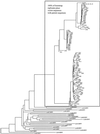Molecular evidence of HIV-1 transmission in a criminal case
- PMID: 12388776
- PMCID: PMC137877
- DOI: 10.1073/pnas.222522599
Molecular evidence of HIV-1 transmission in a criminal case
Abstract
A gastroenterologist was convicted of attempted second-degree murder by injecting his former girlfriend with blood or blood-products obtained from an HIV type 1 (HIV-1)-infected patient under his care. Phylogenetic analyses of HIV-1 sequences were admitted and used as evidence in this case, representing the first use of phylogenetic analyses in a criminal court case in the United States. Phylogenetic analyses of HIV-1 reverse transcriptase and env DNA sequences isolated from the victim, the patient, and a local population sample of HIV-1-positive individuals showed the victim's HIV-1 sequences to be most closely related to and nested within a lineage comprised of the patient's HIV-1 sequences. This finding of paraphyly for the patient's sequences was consistent with the direction of transmission from the patient to the victim. Analysis of the victim's viral reverse transcriptase sequences revealed genotypes consistent with known mutations that confer resistance to AZT, similar to those genotypes found in the patient. A priori establishment of the patient and victim as a suspected transmission pair provided a clear hypothesis for phylogenetic testing. All phylogenetic models and both genes examined strongly supported the close relationship between the HIV-1 sequences of the patient and the victim. Resampling of blood from the suspected transmission pair and independent sequencing by different laboratories provided precaution against laboratory error.
Figures


References
-
- Wei X., Ghosh, S. K., Taylor, M. E., Johnson, V. A., Emini, E. A., Deutsch, P., Lifson, J. D., Bonhoeffer, S., Nowak, M. A., Hahn, B. H., et al. (1995) Nature 373, 117-122. - PubMed
-
- Ho D. D., Neumann, A. U., Perelson, A. S., Chen, W., Leonard, J. M. & Markowitz, M. (1995) Nature 373, 123-126. - PubMed
-
- Coffin J. M. (1995) Science 267, 483-489. - PubMed
-
- Perelson A. S., Neumann, A. U., Markowitz, M., Leonard, J. M. & Ho, D. D. (1996) Science 271, 1582-1586. - PubMed
-
- Ou C.-Y., Ciesielski, C. A., Myers, G., Bandea, C. I., Luo, C. C., Korber, B. T., Mullins, J. I., Schochetman, G., Berkelman, R. L., Economou, A. N., et al. (1992) Science 256, 1165-1171. - PubMed
Publication types
MeSH terms
Substances
Associated data
- Actions
- Actions
- Actions
- Actions
- Actions
- Actions
- Actions
- Actions
- Actions
- Actions
- Actions
- Actions
- Actions
- Actions
- Actions
- Actions
- Actions
- Actions
- Actions
- Actions
- Actions
- Actions
- Actions
- Actions
- Actions
- Actions
- Actions
- Actions
- Actions
- Actions
- Actions
- Actions
- Actions
- Actions
- Actions
- Actions
- Actions
- Actions
- Actions
- Actions
- Actions
- Actions
- Actions
- Actions
- Actions
- Actions
- Actions
- Actions
- Actions
- Actions
- Actions
- Actions
- Actions
- Actions
- Actions
- Actions
- Actions
- Actions
- Actions
- Actions
- Actions
- Actions
- Actions
- Actions
- Actions
- Actions
- Actions
- Actions
- Actions
- Actions
- Actions
- Actions
- Actions
- Actions
- Actions
- Actions
- Actions
- Actions
- Actions
- Actions
- Actions
- Actions
- Actions
- Actions
- Actions
- Actions
- Actions
- Actions
- Actions
- Actions
- Actions
- Actions
- Actions
- Actions
- Actions
- Actions
- Actions
- Actions
- Actions
- Actions
- Actions
- Actions
- Actions
- Actions
- Actions
- Actions
- Actions
- Actions
- Actions
- Actions
- Actions
- Actions
- Actions
- Actions
- Actions
- Actions
- Actions
- Actions
- Actions
- Actions
- Actions
- Actions
- Actions
- Actions
- Actions
- Actions
- Actions
- Actions
- Actions
- Actions
- Actions
- Actions
- Actions
- Actions
- Actions
- Actions
- Actions
- Actions
- Actions
- Actions
- Actions
- Actions
- Actions
- Actions
- Actions
- Actions
- Actions
- Actions
- Actions
- Actions
- Actions
- Actions
- Actions
- Actions
- Actions
- Actions
- Actions
- Actions
- Actions
- Actions
- Actions
- Actions
- Actions
- Actions
- Actions
- Actions
- Actions
- Actions
- Actions
- Actions
- Actions
- Actions
- Actions
- Actions
Grants and funding
LinkOut - more resources
Full Text Sources
Medical
Molecular Biology Databases

